Cats, known for their independent yet affectionate nature, thrive in environments that cater to their instincts and preferences. As a cat owner, creating a comfortable haven for your feline friend is not just a luxury but a necessity for their overall well-being. This is where the charm of DIY cat furniture comes into play. Beyond the joy of crafting something with your own hands, DIY cat furniture offers a tailored solution to meet your cat’s unique needs, providing them with a space they can truly call their own.
Why DIY cat furniture?
In addition to the satisfaction of a hands-on project, DIY cat furniture comes with a host of benefits. It allows you to customize the design to match your home decor while ensuring that the furniture meets your cat’s specific preferences. Not only does this contribute to a harmonious living space, but it also fosters a stronger bond between you and your feline companion.
What to expect in this article:
In the following sections, we’ll delve into the intricacies of understanding your cat’s behavior and needs, guide you through the planning phase of your DIY cat furniture project, and provide creative ideas for building structures that your cat will love. We’ll also emphasize safety considerations, offer tips on personalizing your creations, and provide maintenance insights to ensure the longevity of your DIY cat furniture. Let’s embark on this journey of crafting a haven for your feline friend that is both functional and filled with love.
Understanding Cat Behavior and Needs
Cats are fascinating creatures with distinct natural behaviors that are deeply ingrained in their instincts. Recognizing and accommodating these behaviors is crucial for providing a fulfilling environment for your furry companion.
Natural Behaviors of Cats: Climbing, Scratching, Hiding
Understanding your cat’s natural behaviors is the first step in creating a space that truly resonates with them. Cats are born climbers, seeking elevated spots to observe their surroundings. Scratching, an innate behavior, helps them maintain healthy claws and mark their territory. Additionally, cats have an instinct to find cozy hiding spots, providing them with a sense of security.
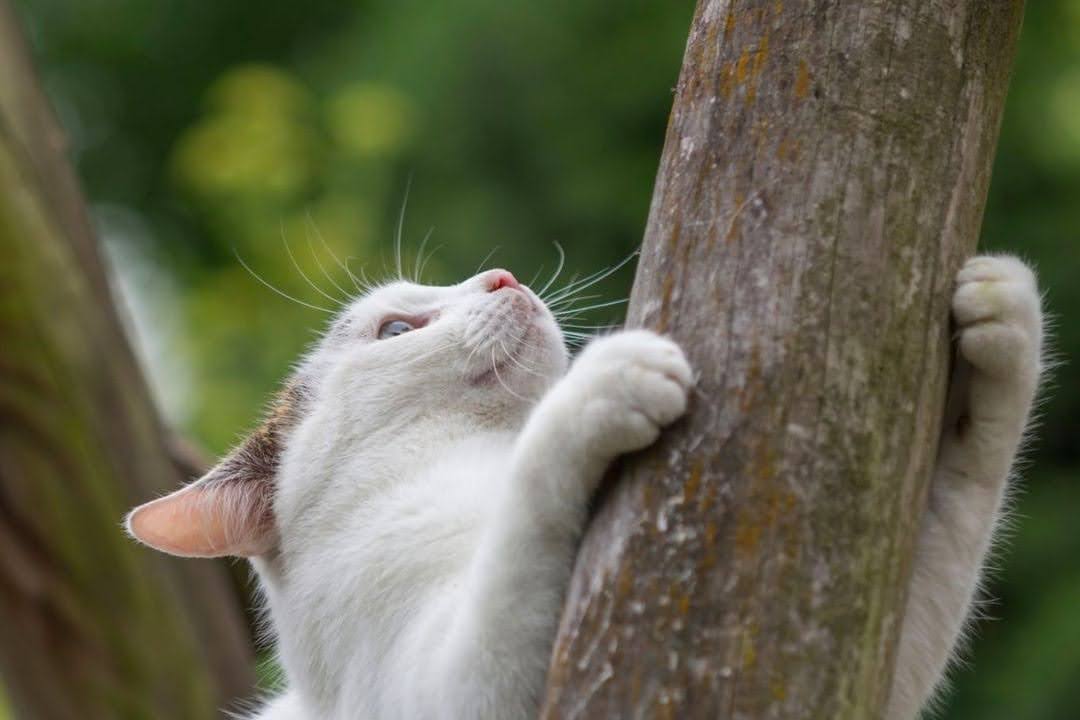
Significance of Satisfying Instincts Through Furniture
Why is it essential to incorporate these behaviors into their living space? By recognizing and satisfying these instincts through purpose-built furniture, you’re not just indulging your cat’s whims but contributing significantly to their physical and mental well-being. Climbing structures allow cats to exercise and express their natural curiosity, while scratching posts fulfill their need to mark territory and keep their claws healthy. Creating hiding spots gives your cat a sense of security and a place to retreat when needed.
Connection Between a Cat’s Environment and Well-being
The link between a cat’s environment and its overall well-being is profound. An environment that caters to their instincts promotes physical health, reduces stress, and enhances mental stimulation. A well-thought-out space that aligns with their natural behaviors fosters a happier, more content cat.
In the upcoming sections, we will guide you on how to incorporate these natural behaviors into your DIY cat furniture projects, ensuring that your creations not only meet your cat’s needs but also contribute to a harmonious coexistence between you and your feline friend.
Planning Your DIY Cat Furniture Project
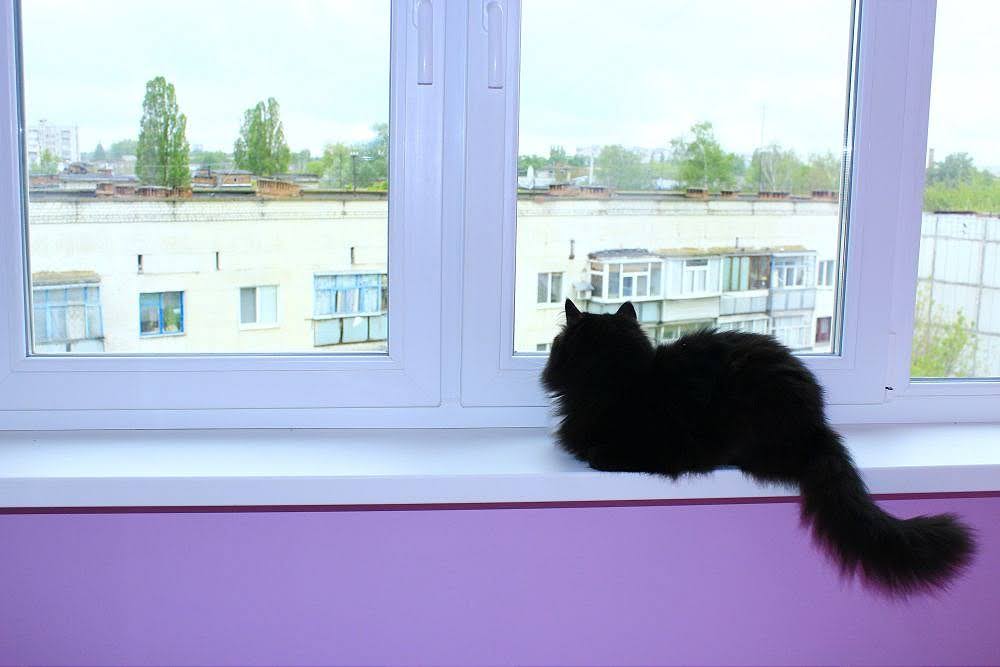
Embarking on a DIY cat furniture project requires thoughtful planning to ensure a purr-fect outcome that both you and your cat will love. Let’s break down the essential steps to guide you through the planning phase.
A. DIY cat furniture for small apartments
Before diving into construction, take stock of your living space. Identify suitable areas where your cat can enjoy the furniture without disrupting the flow of your home. Consider vertical spaces for climbing structures and quiet corners for cozy hideouts. This initial assessment sets the stage for a seamless integration of your DIY cat furniture into your home.
B. Safe DIY cat furniture materials
Cat safety is paramount. Research and choose materials that are non-toxic, durable, and easy to clean. Keep in mind that cats may scratch or chew on surfaces, so selecting materials that withstand these behaviors is crucial. Incorporate safety considerations such as stability and secure fastenings to prevent accidents. This research ensures a cat-friendly and hazard-free DIY project.
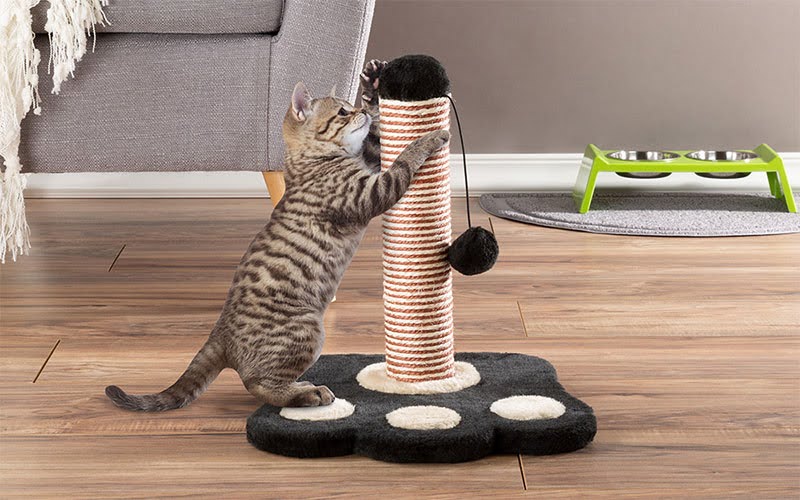
C. DIY cat furniture design ideas
Once you’ve assessed your space and selected cat-friendly materials, sketch out a basic design plan. Consider incorporating features that align with your cat’s natural behaviors, such as climbing platforms, scratching surfaces, and cozy hideouts. A well-thought-out design plan serves as a roadmap for your project, ensuring that you create a piece of furniture that meets both your cat’s needs and your aesthetic preferences.
As we move forward in this DIY cat furniture journey, these planning steps will lay the foundation for a successful and enjoyable crafting experience.
DIY Cat Furniture Ideas
Now that we’ve laid the groundwork in planning, it’s time to delve into the exciting world of crafting specific pieces that will cater to your cat’s natural instincts. Here are some creative DIY cat furniture ideas to get your project started.
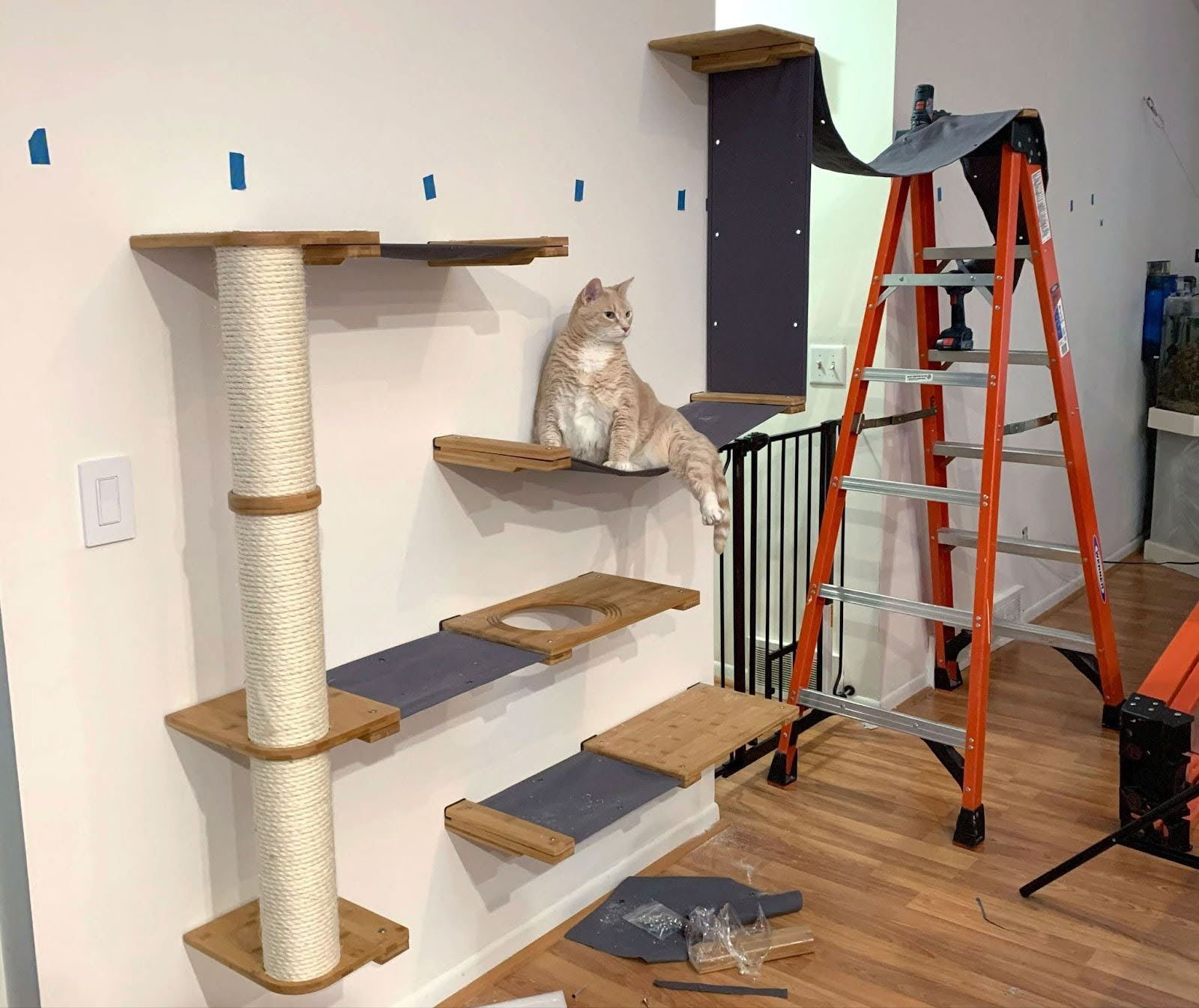
A. Cat Trees: Building a Multi-level Structure for Climbing and Lounging
- Materials Needed
- Plywood or sturdy boards
- Sisal rope for scratching surfaces
- Carpet or faux fur for comfortable lounging areas
- Wood glue and screws
- Power drill and saw
- Step-by-step Construction Guide
- Cut the plywood into different levels for climbing.
- Wrap some levels with sisal rope for scratching.
- Attach carpet or faux fur to create cozy lounging areas.
- Secure the levels together with wood glue and screws.
- Use the power drill for stability and safety.
B. Scratching Posts: Crafting a Durable and Attractive Scratching Post
- Suitable Materials for Scratching Surfaces
- Sisal fabric or rope
- Wooden post or PVC pipe
- Wood base for stability
- Wood glue and screws
- Wrapping Techniques for Durability
- Wrap the wooden post or PVC pipe tightly with sisal fabric or rope.
- Apply wood glue as you go to enhance durability.
- Ensure the wrapping is secure and covers the entire surface.
- Attach the wrapped post to the wood base for stability.
C. Cat Hideouts: Constructing Cozy Spaces for Your Cat to Retreat To
- Using Recycled Materials
- Cardboard boxes or old furniture
- Carpet or soft fabric for lining
- Craft knife or scissors
- Non-toxic adhesive
- Incorporating Soft Bedding
- Line the interior with plush bedding or soft blankets.
- Ensure the space is cozy and inviting for your cat.
- Add a removable cushion for easy cleaning.
- Place the hideout in a quiet corner for your cat’s comfort.
These DIY cat furniture ideas provide a starting point for creating a stimulating and comfortable environment for your feline friend. As you embark on these projects, remember to personalize them based on your cat’s preferences, and stay tuned for more inspiration in the upcoming sections.
Safety Measures and Considerations
When undertaking the creation of DIY cat furniture, ensuring the safety and well-being of your feline companion is paramount. Here, we’ll explore key safety measures and considerations that will not only protect your cat but also enhance the longevity of your crafted pieces.
Ensuring Stability and Durability
Stability is the foundation of any successful DIY cat furniture project. Cats are naturally agile and love to explore elevated spaces. To prevent accidents and ensure the longevity of your creations, focus on stability throughout the construction process.
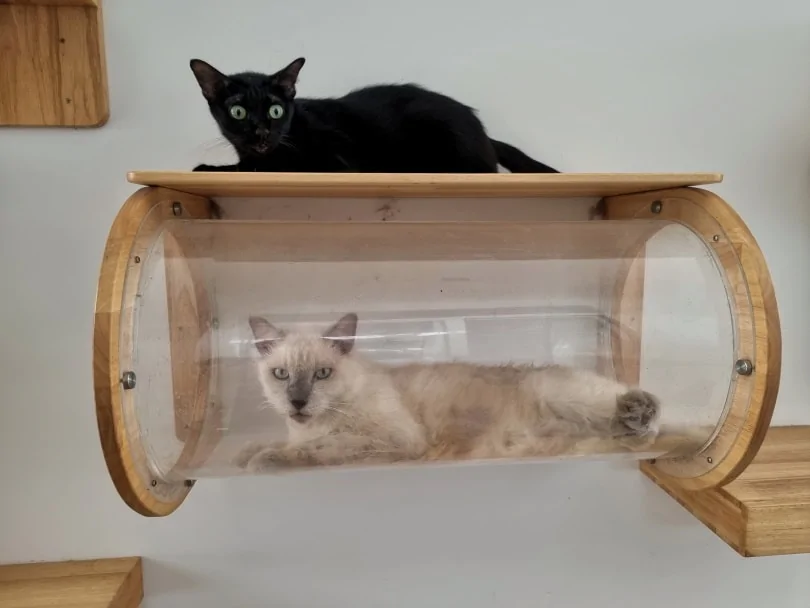
Begin by selecting sturdy materials that can withstand the playful antics of your cat. Plywood, solid wood, and strong PVC are excellent choices. Reinforce joints with wood glue and screws, paying special attention to connections between different levels or components. This ensures that your cat furniture can support your feline friend’s movements without wobbling or tipping over.
Additionally, consider the weight-bearing capacity of your DIY cat furniture, especially if you have a larger or heavier cat. Regularly inspect the furniture for signs of wear, tightening screws or making necessary repairs to maintain its stability over time.
Using Non-Toxic Materials and Finishes
Cats are notorious for exploring the world with their mouths, making it crucial to choose materials that are non-toxic and safe for them. Opt for pet-friendly finishes, paints, and adhesives that do not contain harmful chemicals. Water-based paints and stains are generally a safer option compared to oil-based alternatives.
Check the product labels for any warnings about toxicity, and when in doubt, consult with your veterinarian for advice on cat-safe materials. This precaution extends beyond construction materials to include any fabrics or cushions used in your DIY cat furniture. Your cat’s health and safety should always be the top priority.
To further enhance safety, allow any painted or treated materials to fully cure and ventilate before introducing them to your cat’s environment. This minimizes the risk of your cat ingesting harmful substances during exploration.
Securing Furniture to Prevent Accidents
Cats, being naturally curious and agile, may sometimes engage in activities that could lead to accidental falls or injuries. To prevent such incidents, secure your DIY cat furniture to stable surfaces or anchor them to the wall. This is particularly crucial for tall structures like cat trees.
Use brackets or anchors to attach furniture securely to the wall, ensuring they remain in place even during vigorous play sessions. This simple yet effective measure adds an extra layer of safety, reducing the risk of furniture toppling over.
By implementing these safety measures and considerations, you not only create a secure environment for your cat but also increase the durability and lifespan of your DIY cat furniture.
Personalizing Your DIY Cat Furniture
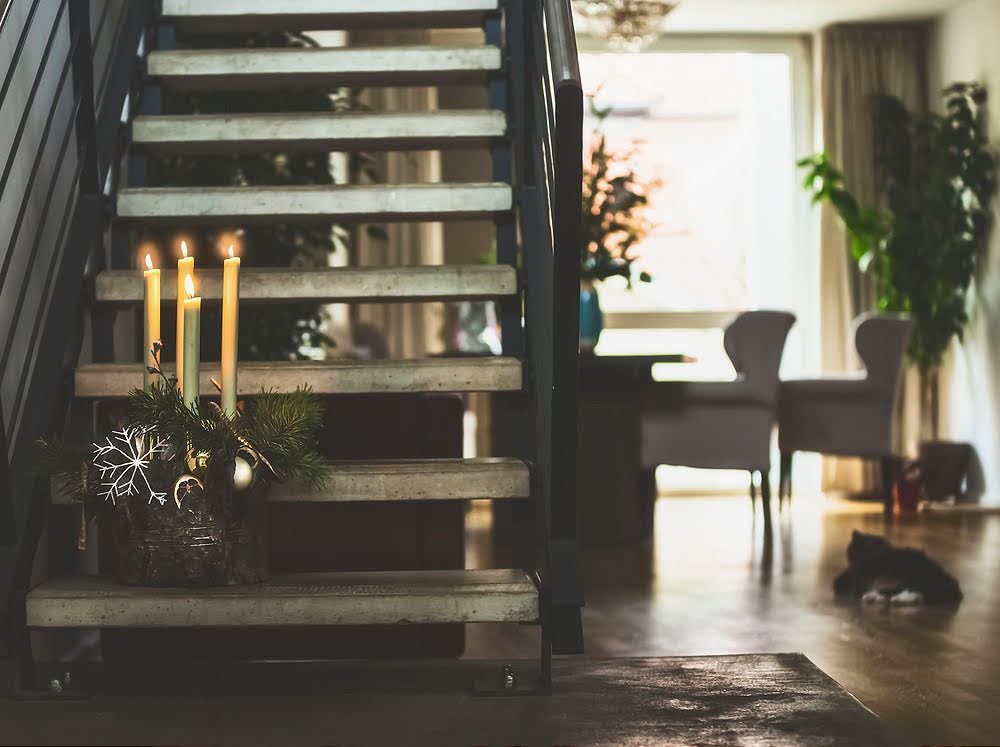
Creating DIY cat furniture is not just about functionality—it’s an opportunity to infuse your cat’s space with personality and style. Let’s explore ways to personalize your creations, making them a seamless and stylish addition to both your home decor and your cat’s preferences.
Adding Decorative Elements to Match Your Home Decor
Elevate the aesthetic appeal of your DIY cat furniture by incorporating decorative elements that align with your home decor. Consider the color scheme, patterns, and materials used in your existing furniture and surroundings. This cohesive approach ensures that your cat’s haven seamlessly integrates into your living space.
Whether it’s painting the cat furniture to match your walls or using fabric that complements your sofa, these small touches can transform a functional piece into a stylish addition to your home. Don’t be afraid to get creative—adding decorative elements not only enhances the visual appeal but also makes the cat furniture feel like a deliberate part of your interior design.
Incorporating Features Based on Your Cat’s Preferences
Every cat is unique, with its own set of preferences and quirks. Personalize your DIY cat furniture by incorporating features that cater to your cat’s individual tastes. Observe your cat’s behavior, noting its favorite activities and resting spots.
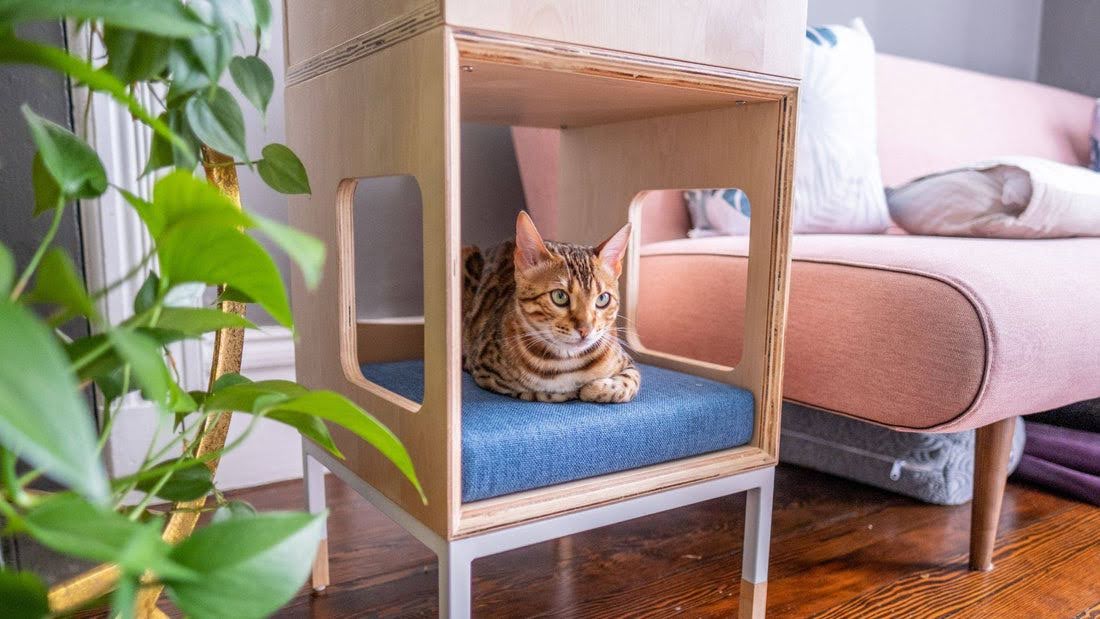
For a cat that loves to perch, add elevated platforms to your cat tree. If scratching is a favorite pastime, ensure there are ample scratching surfaces. Consider incorporating hideouts or cozy corners for a cat that enjoys privacy. By tailoring the features to your cat’s personality, you create a space that not only meets their needs but also becomes a beloved retreat.
Sharing Success Stories or Examples of Personalized Cat Furniture
Inspire others in the DIY cat-loving community by sharing your success stories or examples of personalized cat furniture. Whether it’s through social media, online forums, or blog posts, showcasing your creations can offer valuable insights and ideas to fellow cat enthusiasts.
Share photos, describe the customization process, and highlight how your cat interacts with the personalized furniture. Encourage others to share their experiences and adaptations, creating a collaborative space for DIY cat furniture enthusiasts.
By adding a touch of personalization to your DIY cat furniture, you not only create a space that suits your cat’s needs but also contribute to a visually appealing and harmonious living environment.
Conclusion: Crafting a Haven for Your Feline Friend
As we reach the conclusion of this guide on DIY cat furniture, let’s recap the key points discussed and emphasize the importance of creating a personalized haven for your beloved feline companion.
Summarize the Key Points Discussed in the Article
Throughout this article, we’ve explored the intricacies of understanding your cat’s behavior and needs, planning your DIY cat furniture projects, and unleashing your creativity with specific furniture ideas. We’ve highlighted the significance of safety measures, the use of non-toxic materials, and the importance of stability to ensure a secure and lasting space for your cat. The personalization aspect has been emphasized, encouraging you to blend functionality with style by matching your DIY creations to your home decor and tailoring features to your cat’s unique preferences.
Encourage Readers to Embark on Their DIY Cat Furniture Projects
Now, armed with knowledge and inspiration, it’s time for you, the reader, to embark on your DIY cat furniture journey. Whether you’re a seasoned crafter or a first-time DIY enthusiast, the joy of creating a space that your cat will cherish is immeasurable. Use the information provided as a guide, but don’t be afraid to infuse your unique flair into each project.
Encourage your creativity to flourish as you tailor your DIY cat furniture to your living space and your cat’s individual needs. Remember, the process is as rewarding as the end result, and the bond you strengthen with your feline friend through this shared space is priceless.
Provide a Call-to-Action: Share Your Creations on Social Media or in the Article Comments
We would love to see your DIY cat furniture creations come to life! Share your successes, challenges, and creative twists on social media platforms using relevant hashtags. Connect with other cat enthusiasts, exchange ideas, and inspire fellow pet owners to embark on their own crafting adventures.
If you found this guide helpful or have additional tips to share, we invite you to leave comments below. Your experiences can become valuable resources for others considering similar projects. Let’s build a community of cat lovers who not only provide the best for their feline friends but also share their passion for DIY craftsmanship.
In conclusion, creating DIY cat furniture is a fulfilling endeavor that goes beyond providing a functional space—it’s about fostering a loving and enriched environment for your cat. So, gather your tools, let your imagination run wild, and embark on the journey of crafting a haven that your feline friend will adore. Happy crafting!




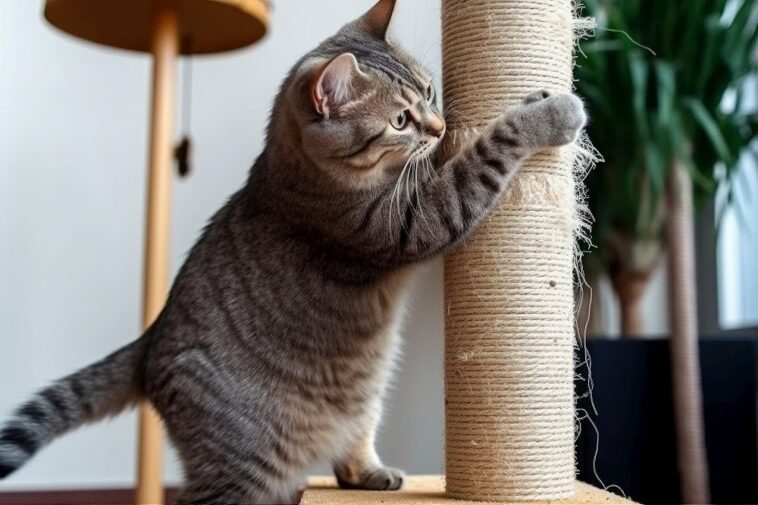


GIPHY App Key not set. Please check settings